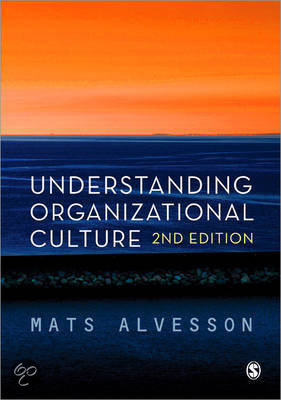Summary Organizational Culture and Change
Summery Organizational Culture and Change
Lecture 1
Literature: Alvesson Chapter 1: the concept of organizational culture
Organizational culture is one of the major issues in academic research and education. There are good
reasons for this: the cultural dimension is central in all aspects of organizational life. Senior
organizational members are always, ‘managing culture’ – underscoring what is important and what is
less so and framing how the corporate world should be understood. A key concern is that culture
management aspires to intervene in and regulate being, so that there is no distance between
individuals’ purposes and those of the organization for which they work. Managers who are aware of
the importance of culture, usually have insufficient knowledge about how people and organizations
function in terms of culture. It is often not possible to obtain cultural control. Culture is complex and
significant. You can try to understand and influence it through a detailed framework and vocabulary
about the core concepts, the culture, the meaning and the symbols.
Corporate cultures were previously seen as important for performance, growth and success. This
came through books (1980s) about successful American companies and the secrets behind successful
Japanese companies. But later on, books showed the problems from these previously successful
companies. Other argued that culture and focus on people was the latest fashion for companies and
managers (1990s). But managers still attribute the success (such as growth) to the culture. Traditional
sources of success (technology, product, access to regulated markets, economies to scale, etc.) are less
important nowadays. Culture is important to it functioning of organizations (from strategic changes to
everyday leadership, how to handle staff, how to treat customers and knowledge is created, shared,
maintained and used.
Relationships between culture and principles such as effectiveness, growth and success are difficult to
make. The main of the author is the understanding of organizational life through organizational
culture. We need to learn about culture also in order to encourage and facilitate the critical thinking-
through of various taken-for-granted aspects of values, beliefs and assumptions in industry,
occupations and organizations.
The meaning(s) of Culture
The term ‘Culture’ does not have a widely accepted meaning / definition. The concept is used in
different scientific disciplines and research orientations, which makes the field so large. Culture can be
about: symbols, ideas, recognition, subconscious, behavioral patterns, etc. The term culture is often
very loosely used, it is more about social patterns, the term informal behavioral patterns or standards
system would be more appropriate. It is important to focus and to hold direction. Most perspectives
have the following assumptions about culture:
• They are related to history and tradition;
• They have some depth, are difficult to understood or to take into account and must be
interpreted
• They are collective and shared by members of groups
• They are primarily ideational in character, having to do with meanings, understandings,
beliefs, knowledge and other intangibles
• They are holistic, intersubjective and emotional rather than strictly rational and analytical.
Most studies see it as a shared world of experiences, meanings values and understandings from which
one obtains information and one reproduces and communicates it. This book uses the term
organizational culture as an umbrella concept for a way of thinking that pays attention to cultural and
1







